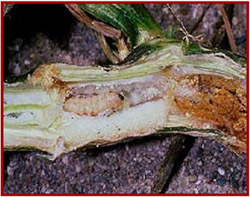Squash Vine Borer
Melittla strayiniformis

Squash Vine Borer images
Found throughout the United States east of the Rocky Mountains, the squash vine borer is a pest of several cucurbit crops. Host plants of the squash vine borer include both wild and cultivated cucurbit members. However, it is rarely found in cucumbers or melons. The squash vine borer can not complete its development except in squash or pumpkins.
Description
Adult squash vine borer adults are called clearwing moths because a large portion of their hind wings lack scales. They are colorful moths approximately ¾-to 1-inch long with 1-to 1½-inch wingspan. The abdomen is a dull orange, marked with black dots running up its middle, although some abdomens may be completely black. The forewings of the squash vine borer are black, fringed with olive-green. Its legs are orange with black and white bands on the ends, and the hind legs are heavily fringed with orange and black hairs. Larvae are yellowish-white with a brown head, 3 pairs of thoracic legs, and 5 pairs of fleshy abdominal prolegs. Larvae are about 1 inch long when full grown. Pupae are brown, slightly less than 1 inch long, and found in the soil in a dark, silken cocoon. Squash vine borer eggs are flattened, oval, and dull-red in color.
Life Cycle
Squash vine borers overwinter as mature larvae or pupae within cocoons 1½-to 3-inches in the soil. Pupation occurs in the spring, and adult moths emerge in June and July. In southern Illinois (and similar latitudes) emergence may begin as early as May. After mating, when plants begin to bloom or "run", females lay eggs at the base of plants, on stems, and on petioles. Eggs are laid singly and hatch in 10 to 15 days. Soon after hatching, larvae begin to bore into the plant. Larvae that hatch on the vine generally remain there to feed, whereas larvae that hatch on the leaf petioles eventually find their way to the base and enter the vine. Feeding occurs for about 4 weeks as larvae complete development. Larvae pass through 4 instars before exiting the stems as mature larvae. Upon leaving the stem, larvae drop to the ground and burrow into the soil where they pupate. In southern Illinois, these larvae will pupate and a second flight of moths will occur in late summer. In more northern areas, the larvae or pupae of the first generation will remain in the soil through the winter.
Injury
The larvae bore into and hollow out the vines. Larvae spend almost their entire life feeding in the plant stem. Feeding within the vines destroys the vascular tissues of the plant, restricting water and food movement, affecting plant vigor and yield. The first indication of a squash vine borer attack will be the sudden wilting of a long runner or of an entire plant in the middle of the day while surrounding plants show no signs of wilting. Because the larvae are within the plant, they are often overlooked; frass extruding from the stem also indicates the presence of larvae within. Squash varieties differ in their susceptibility to vine borer infestation and damage. Hubbard type varieties generally are damaged the most, as are most zucchinis; butternut squash are less susceptible; and acorn and summer crookneck squash are intermediate.

Photo courtesy of Phil Nixon, UI Extension
Scouting Procedure
Scout for moths (pheromone traps and lures are available for monitoring flight periods) and look for entrance holes and frass as soon as plants begin to bloom or vine. Splitting the stem of a wilted plant may reveal if a squash vine borer larva (or larvae) are feeding within the stem. Even though small borers may enter leaf stems, they are most often found toward the base of the plant. Later in the season they may be found throughout the plant and even in the fruit.
Management
Disking or plowing to destroy vines soon after harvest and bury or destroy overwintering cocoons reduces moth populations within a field the following spring. Staggering plantings over several dates also allows some plantings to escape heaviest periods of egg-laying. Early detection of moths and initial damage is essential for timing insecticide applications. To be effective, insecticides must be applied before larvae enter stems or petioles. Apply insecticides as soon as early damage occurs and then again 5 to 7 days later. Continue scouting and treat as soon as new damage in noted.
More Information
- How to Distinguish Between Symptoms of Squash Vine Borer and Bacterial Wilt, Ohio State Vegetable Problem of the Week
(http://www.ag.ohio-state.edu/~vegnet/problem/pb81302.htm) - Squash Vine Borer, Ohio State University Extension Fact Sheet
(http://ohioline.osu.edu/hyg-fact/2000/2153.html) - Curcurbit Insect Management, Purdue University
(http://www.entm.purdue.edu/entomology/ext/targets/e-series/EseriesPDF/E-30.htm)